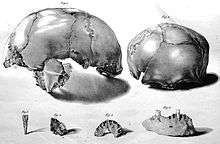Engis 2

Engis 2 refers to a partially preserved calvaria (cranium) and associated fragments of an upper and a lower jaw, a maxillary bone and an upper incisor tooth of a two to three year old Neanderthal child, being part of an assemblage, discovered in 1829 by Dutch physician and naturalist Philippe-Charles Schmerling in the Awirs Cave, situated just north of the Belgian municipality Engis.[1] In 1833 Schmerling described[2] and publicized the find, which included animal bones and stone tools. Recognizing their old age, he associated them with the "Ethiopian Type" of the diluvial period.[3] Although it was not recognized as such until 1936, the publication represents the first scientific description of a Neanderthal fossil.[4]

Misunderstood as to be "modern", the fossil received little attention after its publication in the 19th century as it was compared to Engis 1 - the very good and almost perfectly preserved skull of an adult Homo sapiens. In 1758 Carl Linnaeus had published the 10th edition of his work Systema Naturae in which Homo sapiens as a species name was introduced to the public, yet without a thorough diagnosis and without a precise description of the species-specific characteristics.[5] As a result, any criteria by which a fossil of the species Homo sapiens could be classified into and distinguished from the genus Homo did not exist in the early 19th century. Even Thomas Henry Huxley, a supporter of Darwin's theory of evolution, saw in the 1863 findings of the Engis cave a "man of low degree of civilization" and also interpreted the in 1856 unearthed Neandertal 1 fossils of the Kleine Feldhofer Grotte as to belong within the range of variations of modern man.[6] Additionally, the skull of an infant Neanderthal and an equally old child of anatomically modern humans are of far greater resemblance than their respective adult skulls. The vast majority of the anthropologists of the 19th and early 20th century considered all hominid fossils as to belong to representatives of early "races" of modern man. Hence it was incorrectly believed that the modern man's skull Engis 1 must be related to the child's skull Engis 2.[7]
An exact dating of the finds from Engis stands out to this day.[8] The assignment of Engis 2 to Homo neanderthalensis and Engis 1 to Homo sapiens was primarily based on anatomical and chronological comparisons as Engis 2 was recovered in the context of Neanderthal Mousterian artefacts.[9]
In 1986 cut marks were found on the top of the skull of Engis 2,[10] which were later identified as to be preparation damage " formed during restoration of the vault, moulding striae formed when mold part lines were incised into the fossil and profiling striae formed when craniograms were made with sharp steel instrument tips."[11] The findings are preserved at the Service de Paléontologie Animale et Humaine of the University of Liège. The bone fragments called Engis 3 have gone missing.[12] The evolutionary origin of a 1872 discovered ulna (forearm bone) fragment called Engis 4 is unclear, it has to date not been associated with a specific taxon.[13][14][15]
See also
- List of fossil sites (with link directory)
- List of human evolution fossils (with images)
- Neanderthal
- Neanderthal 1
- Neanderthals of Gibraltar
References
- ↑ "Engis 2". Smithsonian Institution. Retrieved September 27, 2015.
- ↑ "Engis 3 - individuum Engis 2 - Public NESPOS Space". NESPOS Society. Retrieved September 27, 2015.
- ↑ "History of Physical Anthropology, Volume 1". Google Books. Retrieved September 27, 2015.
- ↑ "Wiley-Blackwell Encyclopedia of Human Evolution, 2 Volume Set". Google Books. Retrieved September 27, 2015.
- ↑ "Caroli Linnæi Systema naturæ". Biodiversity Heritage Library. Retrieved September 27, 2015.
- ↑ "Evidence as to Man's Place in Nature by Thomas Henry Huxley - chapter 3". Project Gutenberg. Retrieved September 27, 2015.
- ↑ "Hominids and hybrids: The place of Neanderthals in human evolution Ian Tattersall and Jeffrey H. Schwartz". National Academy of Sciences. Retrieved September 27, 2015.
- ↑ "Patterns of Growth and Development in the Genus Homo". Google Books. Retrieved September 27, 2015.
- ↑ "The Engis 2 Neanderthal child - it is now thought to be about 70 thousand years old), and this illustration was published by Charles Lyell in 1863, in his Antiquity of Man". Dr. Jack Cuozzo. Retrieved September 27, 2015.
- ↑ "Cutmarks on the Engis 2 calvaria?". National Center for Biotechnology Information, U.S. National Library of Medicine. Retrieved September 27, 2015.
- ↑ "Engis: preparation damage, not ancient cutmarks.". National Center for Biotechnology Information, U.S. National Library of Medicine. Retrieved September 27, 2015.
- ↑ "The Human Lineage by Matt Cartmill, Fred H. Smith - Chapter 7 - Talking Apes - The Neanderthals". Google Books. Retrieved September 29, 2015.
- ↑ "Wiley-Blackwell Encyclopedia of Human Evolution, 2 Volume Set". Google Books. Retrieved September 27, 2015.
- ↑ "The Human Lineage by Matt Cartmill, Fred H. Smith". Google Books. Retrieved September 27, 2015.
- ↑ "Cutmarks on the Engis 2 calvaria? - Mary D. Russell and Françoise LeMort". John Wiley & Sons, Inc. Retrieved September 29, 2015.
External links
-
 Media related to Engis 2 at Wikimedia Commons
Media related to Engis 2 at Wikimedia Commons - Science/AAAS - Background - The Neandertal Genome
- Engis 2 - The Smithsonian Institution - Human Origins Program